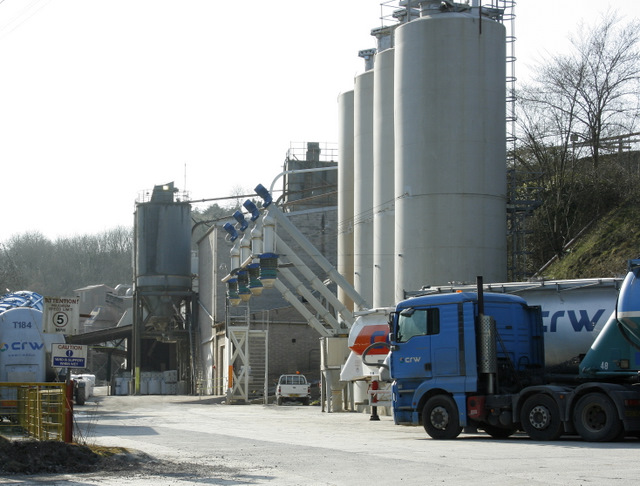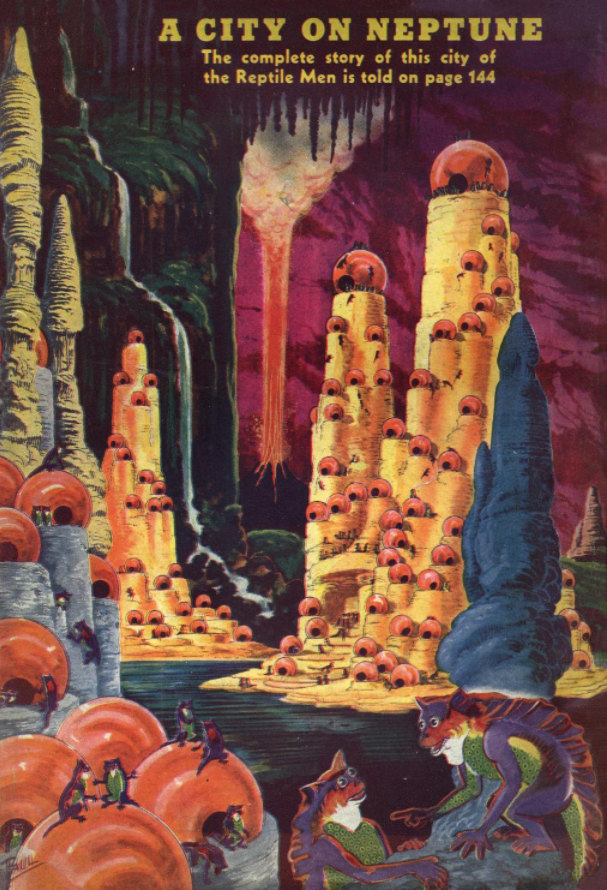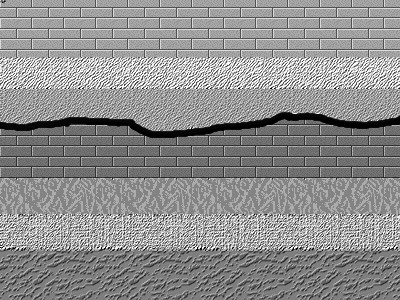|
Gurney Slade Quarry
Gurney Slade quarry, is a limestone quarry near Gurney Slade between Binegar and Holcombe, on the Mendip Hills, Somerset, England. Gurney Slade quarry exhibits pale to very dark grey carboniferous limestone overlain by red and purple-coloured Triassic breccias and marls with a small faulted block of overlying Lower Jurassic breccias forming an angular unconformity with the carboniferous limestone. There is abundant vertical sediment infilling fissures and joints ( Neptunian Dykes). The rocks contain varying amounts of calcite mineralisation, and there is common fossil material associated with the Carboniferous and Jurassic limestones. The limestone within the quarry dips to the south-east at around 30°. Work began at the quarry in the mid 18th century and grew after it was taken over by Francis Flower and Sons in 1928, producing stone for lime-burning. The quarry closed in 1947, but was reopened in 1951 by John Yeoman of Foster Yeoman. The next owner was City Sand and Grav ... [...More Info...] [...Related Items...] OR: [Wikipedia] [Google] [Baidu] |
Breccia
Breccia ( , ; ) is a rock composed of large angular broken fragments of minerals or Rock (geology), rocks cementation (geology), cemented together by a fine-grained matrix (geology), matrix. The word has its origins in the Italian language, in which it means "rubble". A breccia may have a variety of different origins, as indicated by the named types including sedimentary breccia, fault (geology), fault or tectonics, tectonic breccia, igneous breccia, Impact event, impact breccia, and Hydrothermal circulation, hydrothermal breccia. A megabreccia is a breccia composed of very large rock fragments, sometimes kilometers across, which can be formed by landslides, impact events, or caldera collapse. Types Breccia is composed of coarse rock fragments held together by cement or a fine-grained matrix. Like Conglomerate (geology), conglomerate, breccia contains at least 30 percent of gravel-sized particles (particles over 2mm in size), but it is distinguished from Conglomerate (geol ... [...More Info...] [...Related Items...] OR: [Wikipedia] [Google] [Baidu] |
Foster Yeoman
Foster Yeoman Limited, based near Frome, Somerset, England, was one of Europe's largest independent quarrying and asphalt companies. It was sold to Aggregate Industries in 2006. History The company was founded by Foster Yeoman, from Hartlepool, at Dulcote, near Wells, in 1923. He was a former ship owner and had worked in the iron and steel business. After the conflict, with Foster Yeoman ailing, business declined and the company came full circle, returning to a £20,000 turnover it had enjoyed in 1923. During 1949, Foster died and his son, John Foster Yeoman, became a managing director at the age of 21. Educated at Monkton Combe School, Millfield and the University of Bristol, he set about turning the company around, despite his youth and inexperience. John employed Ron Torr to redevelop the plant and, within four years, the company had returned to profit. Dulcote was not the best location and, with an eye to rising costs, competition and the need for future expansion, John ... [...More Info...] [...Related Items...] OR: [Wikipedia] [Google] [Baidu] |
Neptunian Dykes
Neptune has appeared in fiction since shortly after its 1846 discovery, albeit infrequently. It initially made appearances indirectly—e.g. through its inhabitants—rather than as a Setting (narrative), setting. The earliest stories set on Neptune itself portrayed it as a rocky planet rather than as having Neptune#Physical characteristics, its actual gaseous composition; later works rectified this error. Extraterrestrial life on Neptune is uncommon in fiction, though the exceptions have ranged from humanoids to gaseous lifeforms. Neptune's largest moon Triton (moon), Triton has also appeared in fiction, especially in the late 20th century onwards. Neptune Neptune was discovered in 1846 and has made only occasional appearances in fiction since then; in the catalogue of early science fiction works compiled by E. F. Bleiler and Richard Bleiler in the reference works ''Science-Fiction: The Early Years'' from 1990 and ''Science-Fiction: The Gernsback Years'' from 1998, Neptune appe ... [...More Info...] [...Related Items...] OR: [Wikipedia] [Google] [Baidu] |
Fissures
A fissure is a long, narrow crack opening along the surface of Earth. The term is derived from the Latin word , which means 'cleft' or 'crack'. Fissures emerge in Earth's crust, on ice sheets and glaciers, and on volcanoes. Ground fissure A , also called an , is a long, narrow crack or linear opening in the Earth's crust. Ground fissures can form naturally, such as from tectonic faulting and earthquakes, or as a consequence of human activity, such as oil mining and groundwater pumping. Once formed, ground fissures can be extended and eroded by torrential rain. They can be hazardous to people and livestock living on the affected surfaces and damaging to property and infrastructure, such as roads, underground pipes, canals, and dams. In circumstances where there is the extensive withdrawal of groundwater, the earth above the water table can subside causing fissures to form at the surface. This typically occurs at the floor of arid valleys having rock formations and compacte ... [...More Info...] [...Related Items...] OR: [Wikipedia] [Google] [Baidu] |
Unconformity
An unconformity is a buried erosional or non-depositional surface separating two rock masses or strata of different ages, indicating that sediment deposition was not continuous. In general, the older layer was exposed to erosion for an interval of time before deposition of the younger layer, but the term is used to describe any break in the sedimentary geologic record. The significance of angular unconformity (see below) was shown by James Hutton, who found examples of Hutton's Unconformity at Jedburgh in 1787 and at Siccar Point in Berwickshire in 1788, both in Scotland. The rocks above an unconformity are younger than the rocks beneath (unless the sequence has been overturned). An unconformity represents time during which no sediments were preserved in a region or were subsequently eroded before the next deposition. The local record for that time interval is missing and geologists must use other clues to discover that part of the geologic history of that area. The interval ... [...More Info...] [...Related Items...] OR: [Wikipedia] [Google] [Baidu] |
Lower Jurassic
The Early Jurassic Epoch (in chronostratigraphy corresponding to the Lower Jurassic Series) is the earliest of three epochs of the Jurassic Period. The Early Jurassic starts immediately after the Triassic–Jurassic extinction event, 201.3 Ma (million years ago), and ends at the start of the Middle Jurassic 174.7 ±0.8 Ma. Certain rocks of marine origin of this age in Europe are called " Lias" and that name was used for the period, as well, in 19th-century geology. In southern Germany rocks of this age are called Black Jurassic. Origin of the name Lias There are two possible origins for the name Lias: the first reason is it was taken by a geologist from an English quarryman's dialect pronunciation of the word "layers"; secondly, sloops from north Cornish ports such as Bude would sail across the Bristol Channel to the Vale of Glamorgan to load up with rock from coastal limestone quarries (lias and Carboniferous limestone from South Wales was used throughout North Devon/N ... [...More Info...] [...Related Items...] OR: [Wikipedia] [Google] [Baidu] |
Marl
Marl is an earthy material rich in carbonate minerals, Clay minerals, clays, and silt. When Lithification, hardened into rock, this becomes marlstone. It is formed in marine or freshwater environments, often through the activities of algae. Marl makes up the lower part of the White cliffs of Dover, cliffs of Dover, and the Channel Tunnel follows these marl layers between France and the United Kingdom. Marl is also a common sediment in post-glacial lakes, such as the marl ponds of the northeastern United States. Marl has been used as a soil conditioner and neutralizing agent for acid soil and in the manufacture of cement. Description Marl or marlstone is a carbonate mineral, carbonate-rich mud or mudstone which contains variable amounts of Clay minerals, clays and silt. The term was originally loosely applied to a variety of materials, most of which occur as loose, earthy deposits consisting chiefly of an intimate mixture of clay and calcium carbonate, formed under freshwa ... [...More Info...] [...Related Items...] OR: [Wikipedia] [Google] [Baidu] |
Triassic
The Triassic ( ; sometimes symbolized 🝈) is a geologic period and system which spans 50.5 million years from the end of the Permian Period 251.902 million years ago ( Mya), to the beginning of the Jurassic Period 201.4 Mya. The Triassic is the first and shortest period of the Mesozoic Era and the seventh period of the Phanerozoic Eon. Both the start and end of the period are marked by major extinction events. The Triassic Period is subdivided into three epochs: Early Triassic, Middle Triassic and Late Triassic. The Triassic began in the wake of the Permian–Triassic extinction event, which left the Earth's biosphere impoverished; it was well into the middle of the Triassic before life recovered its former diversity. Three categories of organisms can be distinguished in the Triassic record: survivors from the extinction event, new groups that flourished briefly, and other new groups that went on to dominate the Mesozoic Era. Reptiles, especially archosaurs, were the ... [...More Info...] [...Related Items...] OR: [Wikipedia] [Google] [Baidu] |
Limestone
Limestone is a type of carbonate rock, carbonate sedimentary rock which is the main source of the material Lime (material), lime. It is composed mostly of the minerals calcite and aragonite, which are different Polymorphism (materials science), crystal forms of calcium carbonate . Limestone forms when these minerals Precipitation (chemistry), precipitate out of water containing dissolved calcium. This can take place through both biological and nonbiological processes, though biological processes, such as the accumulation of corals and shells in the sea, have likely been more important for the last 540 million years. Limestone often contains fossils which provide scientists with information on ancient environments and on the evolution of life. About 20% to 25% of sedimentary rock is carbonate rock, and most of this is limestone. The remaining carbonate rock is mostly Dolomite (rock), dolomite, a closely related rock, which contains a high percentage of the mineral Dolomite (mine ... [...More Info...] [...Related Items...] OR: [Wikipedia] [Google] [Baidu] |
Carboniferous
The Carboniferous ( ) is a Geologic time scale, geologic period and System (stratigraphy), system of the Paleozoic era (geology), era that spans 60 million years, from the end of the Devonian Period Ma (million years ago) to the beginning of the Permian Period, Ma. It is the fifth and penultimate period of the Paleozoic era and the fifth period of the Phanerozoic eon (geology), eon. In North America, the Carboniferous is often treated as two separate geological periods, the earlier Mississippian (geology), Mississippian and the later Pennsylvanian (geology), Pennsylvanian. The name ''Carboniferous'' means "coal-bearing", from the Latin ("coal") and ("bear, carry"), and refers to the many coal beds formed globally during that time. The first of the modern "system" names, it was coined by geologists William Conybeare (geologist), William Conybeare and William Phillips (geologist), William Phillips in 1822, based on a study of the British rock succession. Carboniferous is the per ... [...More Info...] [...Related Items...] OR: [Wikipedia] [Google] [Baidu] |
England
England is a Countries of the United Kingdom, country that is part of the United Kingdom. It is located on the island of Great Britain, of which it covers about 62%, and List of islands of England, more than 100 smaller adjacent islands. It shares Anglo-Scottish border, a land border with Scotland to the north and England–Wales border, another land border with Wales to the west, and is otherwise surrounded by the North Sea to the east, the English Channel to the south, the Celtic Sea to the south-west, and the Irish Sea to the west. Continental Europe lies to the south-east, and Ireland to the west. At the 2021 United Kingdom census, 2021 census, the population was 56,490,048. London is both List of urban areas in the United Kingdom, the largest city and the Capital city, capital. The area now called England was first inhabited by modern humans during the Upper Paleolithic. It takes its name from the Angles (tribe), Angles, a Germanic peoples, Germanic tribe who settled du ... [...More Info...] [...Related Items...] OR: [Wikipedia] [Google] [Baidu] |










